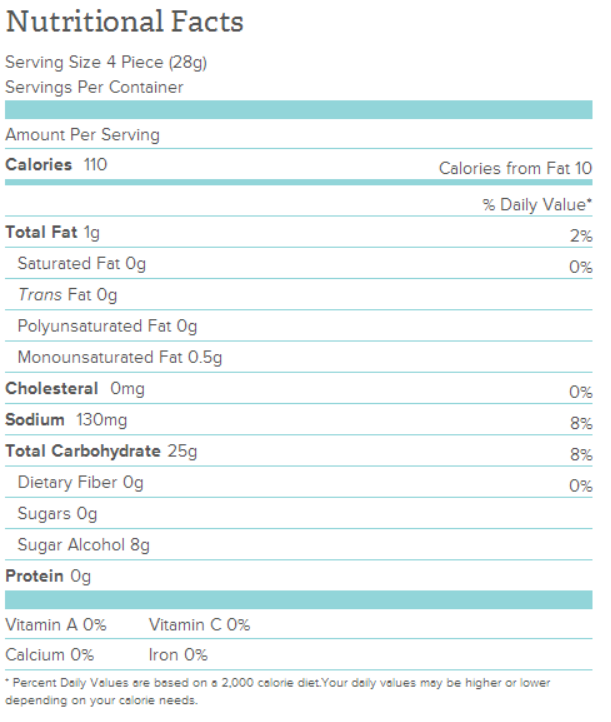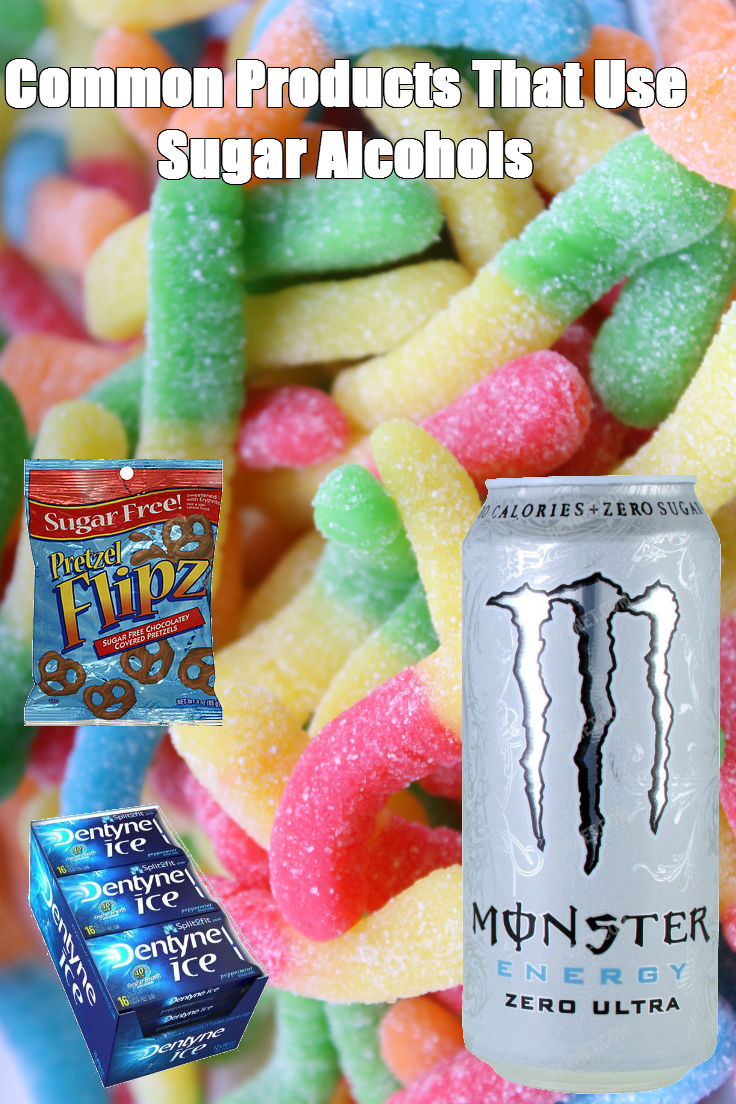How Do They Make Sugar Free Candy Sweet?
We're on a bit of a health kick here at CandyStore.com. It might seem odd to hear that the purveyors of sugar-filled treats has focused on health in recent weeks. We see no issue with it. You can live a perfectly healthy existence while indulging in your favorite confections every now and again.
Last week we looked at some healthy dessert recipes, which mostly mimicked our favorite candy bars. They're the kinds of recipes you can make on a Saturday nigth with the family and not feel bad about on Sunday morning.
This week we're diving into a different aspect of guilt-free sweets: sugar-free candies. After all, it's the sugars we fear, right? If we can remove them from the equation, we can enjoy our favorite candies more frequently.
Not so fast. Something has to make those candies sweet. If you seek a healthier lifestyle, chances are you want to know what you're putting into your body.
So how exactly do they sweeten sugar-free candies?
Sugar Alcohols
Whenever you see the sugar-free label on candy, chances are that it's sweetened with sugar alcohols — which is kinda funny, because sugar alcohols contain neither sugars nor alcohols. So what are they? From Joslin Diabetes Center:
Sugar alcohols come from plant products such as fruits and berries. The carbohydrate in these plant products is altered through a chemical process.
Two important points about sugar alcohols in general:
1) They do have carbohydrates. While sugar alcohols do contain fewer calories and carbohydrates than table sugar, they still do contain calories and carbohydrates. They will, therefore, affect your blood sugar levels.
Check out the nutritional facts for sugar-free Salt Water Taffy Lite.
While it indeed contains no sugar, it does have 25g of carbohydrates and 110 calories per serving. Compare that to standard Salt Water Taffy, which has the same 110 calories, and only 21g of carbohydrates, per serving. The only difference is the 13g of sugar in standard salt water taffy.
2) You don't digest sugar alcohols. One reason sugar alcohols don't spike blood sugar to the same levels as table sugar is that we don't fully digest sugar alcohols. That's not entirely a good thing. While it means you can avoid some of sugar's health-threatening properties, it also means exposure to new, uh, issues, as it were.
If you have the stomach read this blurb from The Atlantic. The long-and-short: because you don't fully digest sugar alcohols, they can ferment in the gut. You can use your imagination from there.
There are a few types of sugar alcohols, so let's get familiar.
Maltitol
Maltitol is typically use in gummy candies, such as Sour Gummi Worms. So if you've enjoyed those chewy treats without extra trips to the bathroom, you can thank maltitol.
There certainly are some downsides to maltitol. While it does have fewer calories per gram than table sugar, the differences aren't that great (4 calories per gram from sugar, 3 calories per gram from maltitol). It also has a relatively high glycemic index of 36 in powder form, but 52 in syrup form, which is how you'll usually find it used in gummy candies. For reference, table sugar has a glycemic index of 60.
Given the high glycemic index and relatively few caloric savings — plus the potential gastrointestinal distress — you might be better off just eating the full-sugar versions of gummy candies.
Sorbitol
Another common sugar alcohol you'll see on many ingredients lists is sorbitol. You'll find this one commonly in sugar-free chewing gum, such as Dentyne Ice. While it's not quite as sweet as maltitol, it's also not even close to it on the glycemic index. Sorbitol, and most of its other sugar alcohol cousins, are in the single digits.
Oftentimes you'll see products that mix sorbitol and another sugar alcohol. For instance, our sugar-free Chick-O-Stick Nuggets contain a sweetener called polyglycitol, which is indeed a combination of sorbitol and maltitol. Since this is, at least in the case of Chick-O-Sticks, in syrup form, you can expect that it will have a more severe effect on blood sugar than if it were in powder form.
Interesting note: sorbitol is also used in soaps because of its moisturizing effects. I'm not sure that fact makes it any more appetizing. Less so, probably.
Erythritol
At about a quarter-calorie per gram and a glycemic index of 1, it might seem as though erythritol is the sugar-free answer we've sought. What exactly is it? From Decoded Science:
Erythritol is a naturally-occurring molecule, we can find it in fruits such as pears, water melons and grapes; it is also present in some drinks like sake and wine, and sauce such as soy sauce.
Sounds great!
Due to its large demand, however, the erythritol we use is produced at an industrial level with a fermentation process, using maize/corn as starting material.
D'oh! Not that corn is in itself bad, but we're probably talking about heavily processed GMO corn. The scariest part of the processing: they use a fungus to ferment erythritol. Yeah. A later part of the process involves filtering the erythritol "to completely remove the fungus responsible for the fermentation." Yikes.
Still, it seems that overall erythritol is the least objectionable of the sugar alcohols (you'll see the conern with xylitol in just a moment). You can find erythritol in artificial sweeteners such as Truvia, which they combine with stevia leaf for a robust sweetener. DeMet's chocolates, such as Turtles and Flipz chocolate-covered pretzels also use erythritol as a sweetener. Some energy drinks, such as Monster Ultra Zero, contain erythritol.
Xylitol
It's not as difficult to pronounce as it looks, and it's probably not as natural as people claim. Xylitol has caught some attention of late, because it is a "natural" sugar alcohol.
Why the scare quotes around the word natural? It is, in some ways, natural. From The Healthy Home Economist: "Manufacturers of xylitol market it as derived from xylan, which is found in the fibers of many plants including berries, oats, beets, sugar cane and birch." Sounds great, right?
Eh, not so fast. She goes on:
While it is true that xylitol is a naturally occurring substance, manufactured xylitol is another matter entirely. Commercially available xylitol is produced by the industrialized process of sugar hydrogenation. In order to hydrogenate anything, a catalyst is needed, and in the case of xylitol, Raney nickel is used which is a powdered nickel-aluminum alloy.
Mmmmm…heavy metals. Seriously, go read that whole post. It really puts a damper on xylitol as some kind of healthy, natural sugar substitute panacea.
(Another shiver-inducing fact: two pieces of xylitol-sweetened gum kills 100-gram rats in approximately 50 percent of tests. Yes, we're quite a bit more than 100 grams, but sheesh.)
If you're sufficiently scared off of sugar alcohols, it's time to move onto the other category of sugar-free candies.
Artificial Sweeteners
Technically, at least according to the FDA, sugar alcohols are not artificial sweeteners. Never mind the processing! They're made from GMO corn and other "natural" products!
Anyway, the FDA has approved only six artificial sweeteners. The latest (from that link) is called advantame. The others are neotame, saccharin, aspartame, acesulfame potassium, and sucralose. Of those, sucralose and aspartame seem to be the most common.
(There was plenty of controversy surrounding the FDA's decision to approve aspartame, despite a Public Board of Inquiry ruling that it was not safe. Newly inaugurated President Ronald Reagan fired the head of the FDA and appointed someone who would push approval of aspartame. If you don't like messy corporate-political partnerships, don't read this timeline.)
All of these artificial sweeteners have zero glycemic index. That's sensible, given that they're artificial and scientists can therefore manipulate them. Why go through the trouble of creating an artificial sweetener that does spike your blood sugar?
Sucralose has become a fashionable sweetener of late. It is derived from table sugar, but you probably don't want to know how it's derived. But we'll tell you anyway: it's by chlorinating it. So if the next time you open a packet of Splenda and think about pool water, well, you know who to thank.
The original draw of sucralose was that you could use it in baking. That wasn't the case with aspartame-based sweeteners such as NutraSweet and Equal, nor with the saccharin-based Sweet'N Low. By this point sucralose has found its way into thousands of products, including soft drinks, sauces, and energy bars. Our Sugar Free Starlight Mints are sweetened with sucralose.
If you consume products containing sucralose, you might not want to read this article from Down to Earth. "The human body is very good at detoxifying itself of certain substances, but this is not the case with organochlorine compounds, which are organic compounds that have been chlorinated." So we're already starting off on shaky ground. And then there's this:
"The FDA claims that sucralose is 98 percent pure, but what about the other 2 percent? It contains heavy metals like lead, arsenic, triphenilphosphine oxide, methanol, chlorinated disaccharides, and other potentially dangerous substances."
What's worse: despite a glycemic index of zero, sucralose might cause an insulin response. So while you get no calories, you can still realize negative side effects. This is particularly troublesome for diabetics, who need to manage their blood sugar levels.
For diabetics, sugar alcohols and artificial sweeteners can be the only way they can enjoy facsimiles of their favorite candies. We are happy to offer a selection of sugar-free candies that anyone can enjoy.
Yet the downsides of artificial sweeteners and sugar alcohols should give us pause. Are we really doing our bodies any favors by ingesting them? Given everything we've laid out in this post, it sure seems that enjoying the normal, sugared versions of our favorite candies is the best course of action.
In moderation, of course.
-
Tags:
- Candy Facts & Trivia



